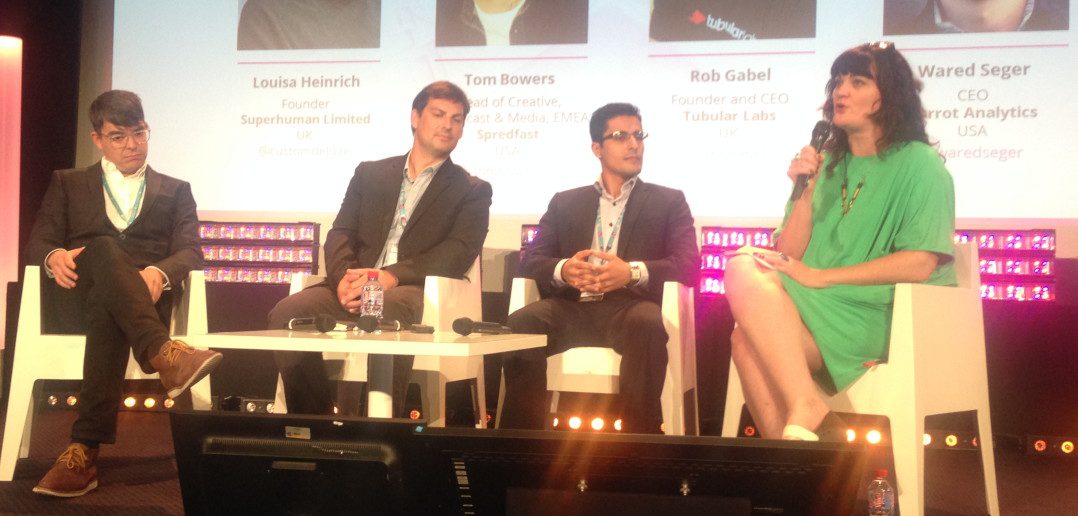Left to right: Tom Bowers, head of creative, broadcast & media, EMEA, Spredfast; Rob Gabel, founder and CEO, Tubular Labs; Wared Seger, CEO, Parrot Analytics; and moderator Louisa Heinrich, founder of Superhuman Limited.
Three data experts gathered round to talk about data’s role in the creative process, both for content creators and distributors. As a quick recap, Spredfast tracks social marketing campaigns. Tubular Labs provides digital video intelligence, and Parrot Analytics works with industry leaders, creatives and scientists to help solve today’s industry problems and shape its future.
A number of topics were addressed in this half-hour, but we’ll focus on two key ones. Heinrich began by asking, « What are some things you wish people would do with data and analytics? »
« If I had to pick one … I’d suggest we apply the Moneyball example and leverage data as part of the decision-making process from beginning to end, to hopefully improve these numbers that are so dreadful, » Seger said.
Bowers looked at things from a social perspective. « Social data is just looked at as an individual tweet or opinion, » he said. « But if you take the overview, you could change editorial … and produce something that resonates further with audiences. »
For his part, Gabel expressed a desire to see data used more often to partner with content creators. « The media and brand companies tend to be in the tail [of the longtail]… there are all these creators who you haven’t heard of, who have an audience, a brand voice. They’re mini Oprahs, mini Anderson Coopers, and some of them like your brands. They have strong opinions on how to make things. »
The idea would be to approach these people and collaborate with them to produce valorising content that is actually both useful and relevant to the people you’re speaking with. « It’s not traditional casting. You’re not hiring them to say a line, you’re working with them to co-create content, » said Gabel.
Another observation Heinrich made was that people often assume that by using data, we’re shutting down creativity and squeezing out storytellers. « What do you say to them? » she asked the panel.
« You need to have the inside layer to drive creativity because it’s the proof point, » said Bowers. « You have to justify why people should pay money on engagement or interactivity in programme. If you just say ‘this is a great creative idea, it might be a great hit’, often there isn’t a budget to justify that. If you have the data to back it up, often that takes things over the line. »
Creativity needs constraints, » Gabel added. He then told the story of one client, a game show network that wanted a YouTube channel but saw that game shows aren’t big on YouTube.
« What do you do as a creative? » he asked. « You could make a game show, and it may or may not work. But you look at the data, and find that pranks are very popular. It’s an interesting area where you can make fun game shows for passionate audiences around pranking. »
The channel did get made, and data was also used to pick contestants who had an audience worth bringing with them.
« I don’t think creativity can be replaced, » said Seger. « The innate human creative process, there always needs to be room for that. Unguided, pure, human creative process. » However, he added, « I think you can support that. In data science we look at the negative spaces between what’s happening out there and what’s not happening—what there is space for. Unfortunately a lot of the current creative process is about making the 40th vampire movie. Data science can tell you whether that 40th vampire movie will boost that category or kill it. »
Bowers agreed about the importance of looking at data to fill negative space or potential touchpoints. « There’s a lot of fear around integrating social because there is so much wasted airtime, » he said. « But if you can finesse content, insert it where you can drive new formats, that’s where the opportunity lies. »
Seger added that the negative space idea can also be applied to distribution. « US content has always gone out to the world; there’s a lot of international demand for it, » he observed.
« But we’re seeing an increasing trend where local productions are starting to gain international production—like Turkish dramas in Latin America. Telenovelas have a lot of demand in the Middle East. These are very insightful trends that you can pick up by just looking at what’s happening in global demand. »




